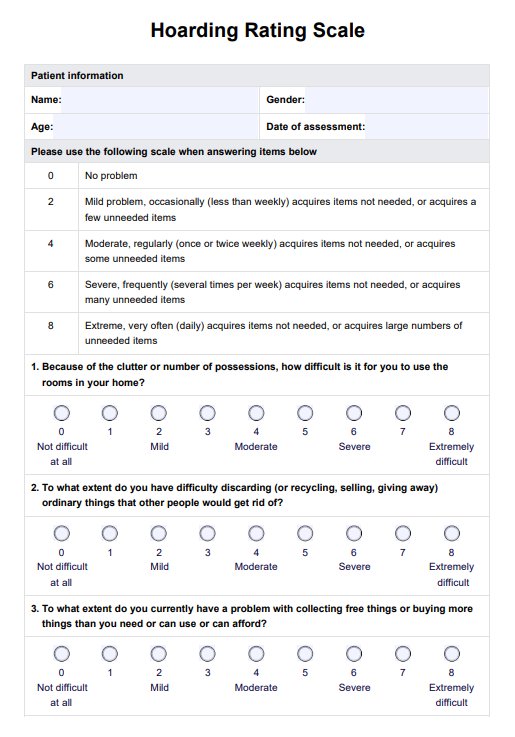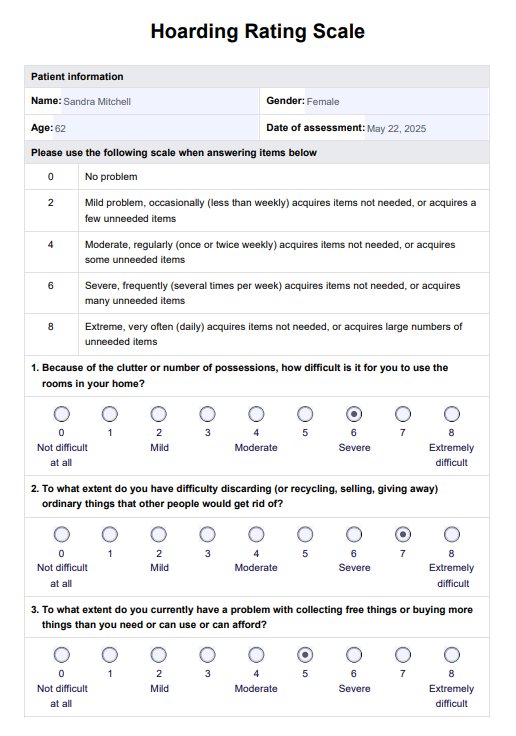Hoarding Rating Scale
Learn about the Hoarding Rating Scale, understand how it is used for assessing hoarding behavior, and access Carepatron's free PDF download of the scale with an example for reference.


What is the Hoarding Rating Scale?
The Hoarding Rating Scale (HRS) is a standardized tool designed to assess hoarding behavior and symptoms associated with hoarding disorder. It helps clinicians and researchers evaluate the severity of hoarding symptoms in individuals.
The scale self report addresses key aspects such as clutter difficulty discarding, excessive acquisition, and the impact of hoarding on daily functioning. It can be administered through a structured interview format known as the Hoarding Rating Scale-Interview (HRS-I) or as a self-report questionnaire (HRS-SR). Both versions have shown high internal consistency and are widely used in clinical assessments.
Developed to complement existing diagnostic criteria for hoarding disorder, the HRS considers compulsive hoarding as distinct from other obsessive-compulsive spectrum disorders. It provides cutoff scores that indicate the presence and severity of hoarding symptoms, aiding in differential diagnosis and treatment planning.
For clinicians, the HRS together with a clutter image rating offers a reliable method to quantify and track hoarding symptoms over time, while researchers use it to study the efficacy of interventions and the natural history of compulsive hoarding behavior.
Scoring and interpretation
The Hoarding Rating Scale is scored based on a structured assessment of hoarding behaviors. Respondents rate the frequency and severity of each behavior on a scale from 0 (no problem) to 8 (extreme, very often).
To calculate the total score using the HRS-SR (self-report version), sum the ratings from the five questions. Scores range from 0 to 40, with higher values indicating more severe hoarding symptomatology [12]. This scoring method provides a quantitative measure that helps clinicians assess the extent and impact of hoarding behaviors, guiding treatment planning and intervention strategies effectively.
Hoarding Rating Scale Template
Hoarding Rating Scale Example
How to use our Hoarding Rating Scale template
Our Hoarding Rating Scale template by Carepatron is designed to streamline the assessment of hoarding disorder, ensuring accurate and comprehensive evaluations. Medical professionals can utilize this template effectively by following these straightforward steps:
Accessing the template
Start by accessing the Hoarding Rating Scale template on the Carepatron platform. Ensure you have the necessary permissions and access credentials.
Setting up the assessment
Begin the assessment by entering the patient's demographic information and relevant clinical history into the template.
Administering the scale
Choose between the Hoarding Rating Scale-Interview (HRS-I) for structured interviews or the self-report version (HRS-SR) for patient self-assessment. Administer the scale according to the selected format.
Scoring and interpretation
Score the responses based on predefined criteria, focusing on key aspects such as clutter difficulty discarding, excessive acquisition, and the impact of hoarding on daily life. Use the provided guidelines to interpret the scores accurately.
Review and documentation
Review the completed assessment for accuracy and completeness. Document the findings in the patient's medical record, ensuring clarity and conciseness.
Follow-up and monitoring
Schedule follow-up assessments as necessary to monitor changes in hoarding symptoms over time. Use the template to track progress and adjust treatment plans accordingly.
How this scale benefits mental health professionals
The Hoarding Rating Scale (HRS) offers significant advantages to mental health professionals in assessing and managing hoarding disorder effectively. Here are three key benefits:
Enhanced diagnostic precision
Using the HRS, mental health professionals can conduct structured assessments that enhance diagnostic precision. The scale's criteria for clutter difficulty discarding, excessive acquisition, and other key symptoms provide a standardized framework for evaluating hoarding disorder across various stages. This consistency supports accurate diagnosis and differentiation from other disorders such as obsessive-compulsive disorder (OCD).
Tailored treatment planning
By utilizing the HRS, mental health professionals can tailor treatment plans based on comprehensive assessments. The scale's total score and itemized responses guide clinicians in identifying specific areas of difficulty for each patient. This personalized approach ensures that interventions address individual needs effectively, whether through cognitive-behavioral therapy, medication management, or other therapeutic modalities.
Monitoring progress over time
The HRS facilitates longitudinal assessment by allowing mental health professionals to track changes in hoarding symptoms over time. Whether administered as a self-report or through a brief interview, the scale's internal consistency and sensitivity to change enable clinicians to monitor treatment efficacy and adjust interventions accordingly. This ongoing evaluation supports continuity of care and improves outcomes for patients with hoarding disorder.
Commonly asked questions
The 5 levels of hoarding are a classification system used to categorize the severity of hoarding disorder based on clutter and living conditions. They range from Level 1 (minimal clutter) to Level 5 (extreme clutter and unsanitary conditions).
Hoarding scale rating refers to tools like the Hoarding Rating Scale (HRS) used to assess and quantify hoarding behaviors and symptoms. It helps clinicians determine the severity of hoarding disorder through structured criteria.
A Level 1 hoarder typically has minimal clutter that does not significantly impact living spaces. They may have difficulty discarding items but generally maintain functional living conditions.
Yes, hoarding can be reported to authorities or mental health professionals if it poses a risk to the individual or others. Reporting aims to ensure appropriate intervention and support for the hoarder's well-being and safety.




















-template.jpg)


















































































